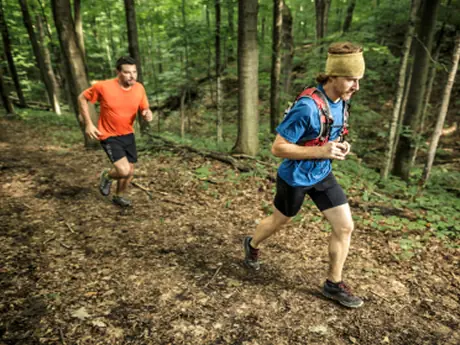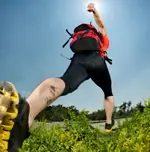
For trail runners, hills are a big part of training and racing. The feel of your heart pounding in your chest and your shortness of breath at the top of the hill attest to what hills provide for your cardiorespiratory system. But they also provide a great workout for your skeletal muscles.
Hill training:- Increases leg-muscle power
- Can be used as a transition into more formal speedwork
- Improves the performance of the heart since heart rate can easily climb up to its maximum when running up a hill
- Uses the muscles of the legs, arms, and trunk in ways that are different from flat running
More: Hill Training: Speedwork in Disguise
Physiology of Hills
Even though running uphill seems harder—your heart must do more work to send blood and oxygen to a large muscle mass that must work against gravity—downhills actually cause the biggest problems. If you've ever run a race with long or steep downhills, you know what running downhill can do to your legs.
Running downhill is tough because the gravity-induced eccentric muscle contractions, during which your muscle fibers are forced to lengthen, causes them to tear. Eccentric contractions are also unique in that fewer muscle fibers are active compared to other types of muscle contractions, causing the force generated to be distributed over a smaller area of muscle. A greater force over a smaller area equals greater tension, which causes even more damage.
The forces of impact and braking are also greater during downhill running compared to uphill and flat running. Therefore, running downhill carries a greater risk of overuse injury compared to uphill or flat running. The muscle damage decreases your muscles' ability to produce force, which slows your pace on the flat and uphill portions of the trail, and leads to delayed-onset muscle soreness, which includes an inflammatory response that lasts for a few days following the run as your muscle fibers heal.
The good news is that damaging muscle fibers with eccentric contractions makes them heal back stronger, protecting them from future damage. While you can expect your muscles to be sore after the first time running downhill, subsequent downhill workouts will cause less soreness since running downhill has a prophylactic effect on muscle damage and soreness.
More: What Causes Delayed Onset Muscle Soreness?
Downhill running also affects running economy, the amount of oxygen you consume to maintain a given submaximum pace. A number of studies have shown a significant decrease in running economy for up to one week following a 30-minute downhill run on a 10 to 15 percent grade.
- 1
- of
- 2
About the Author

Get ACTIVE on the Go


Couch to 5K®
The best way to get new runners off the couch and across the finish line of their first 5K.
Available for iOS | Android








Discuss This Article